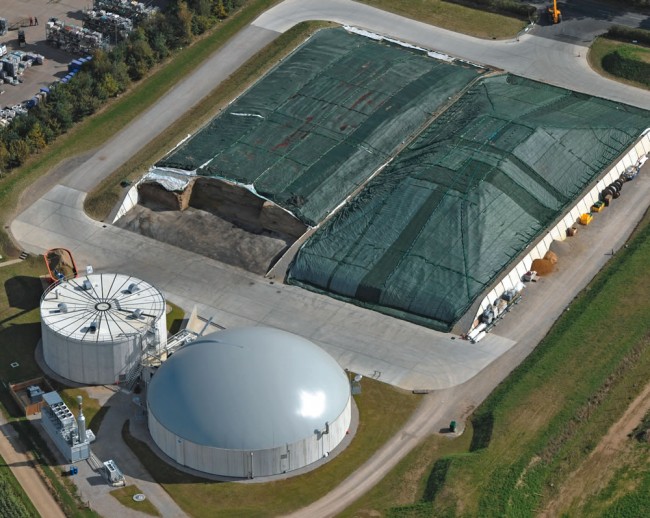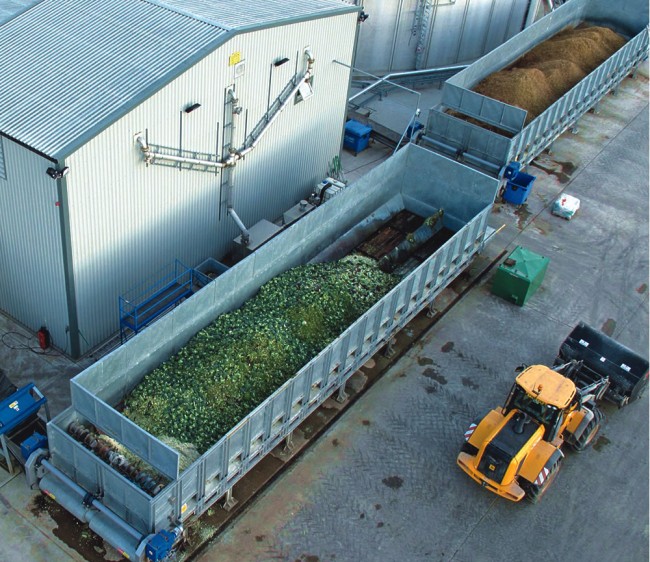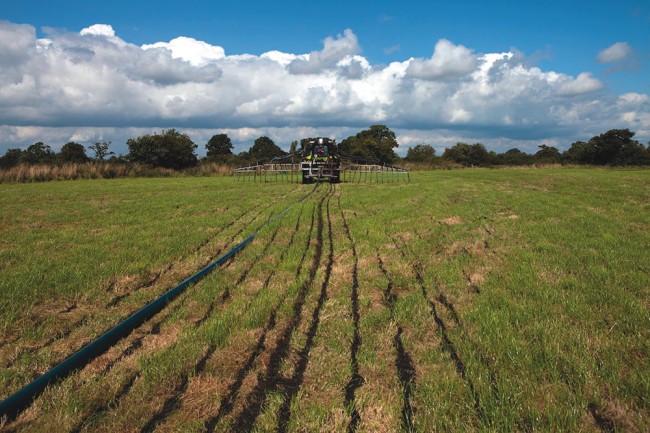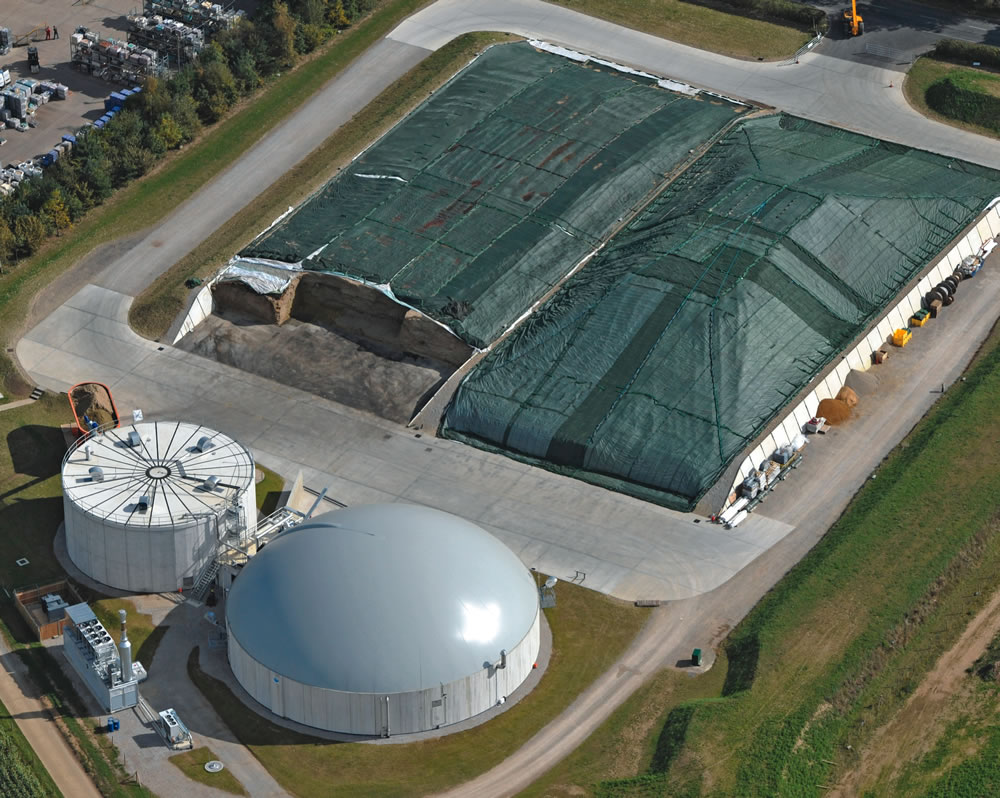The AD sector in the UK has grown exponentially with 108 nonwater industry plants as of April — up from 74 a year ago. The ADBA outlines key steps needed to continues this pace.
Matt Hindle
BioCycle May 2013, Vol. 54, No. 5, p. 41

Of the UK’s nonwater industry plants, 44 use agricultural feedstocks such as slurries and crops. One example is the Spring Farm anaerobic digester in Norfolk, UK.
The UK AD market is diverse with plants of a wide range of sizes, treating a variety of different feedstocks. Of the UK’s nonwater industry plants, 44 use agricultural feedstocks such as slurries and crops, 47 treat food waste from various sources including supermarkets and households, and 17 are based on industrial sites, treating on-site waste such as brewery effluent. Primarily because of the way the financial incentives regime developed, the vast majority of plants operating today are generating electricity through combined heat and power (CHP) engines, and making some use of the heat. However, the Renewable Heat Incentive was recently introduced, and the UK now has three biomethane to grid plants, including the first commercial scale plant launched by the Prince of Wales in Poundbury, Dorset, in 2012. The Renewable Heat Incentive offers financial support for 20 years for biomethane injected into the gas grid at all scales, as well as heat produced from biogas plants with a thermal capacity up to 200 kW.
To realize the real potential for AD to contribute to the circular economy — by making the best use of finite resources and recycling nutrients back into food production, energy and food security, climate change, air quality and the economy — there are still barriers that the industry must overcome. Anaerobic digestion’s multiple benefits can sometimes act as a handicap given the need for government policy to be joined up across policy areas as diverse as waste, bioenergy, transport and agriculture.

Food waste from households and commercial generators such as grocery stores is received at 47 nonwater industry digesters, including the Staples AD plant in Lincolnshire, UK.
Key Challenges And Solutions
To address these issues and support ongoing development, the Anaerobic Digestion and Biogas Association (ADBA), has highlighted six key challenges and their solutions:
The Investment Risk: AD is still reliant on government incentives to attract finance, build confidence and achieve growth. Potential investors can be nervous about uncertainty over tariff levels and key policies in areas such as waste, transport and bioenergy. Stability will come from long-term support at sufficient levels to reflect the risks, with capacity triggers (e.g., the 200 kW limit in the Renewable Heat Incentive) set at sensible levels and a workable preaccreditation system across all incentive schemes. At present, for example, the preset levels of deployment, if reached, will trigger reduced Feed-in-Tariff levels in April 2014. There is concern this has been set at too low a level, which could therefore cause investor confidence to be damaged. A preliminary accreditation model, which locks in a tariff rate prior to a project’s completion, can help to tackle this uncertainty.
Access To Feedstock: Irrespective of financial stability, without feedstock there is no AD industry. The best way to increase the volume of material available for processing through AD would be to support source segregated collections of organic waste and consider implementing a ban on biodegradable material sent to landfill, as the Scottish Government has done. Crops for AD are also a significant potential feedstock, offering additional benefits to farming over and above energy production, and should be clearly supported. Climate change targets cannot be met without sustainably produced bioenergy, but just as importantly, our nation’s food security is dependent on recycling the valuable nutrients contained in the food waste and other organic feedstocks.
Grid Connection For Biomethane: Injection of biomethane (renewable natural gas (RNG)) into the grid could account for over 50 percent of biogas generated by 2030. To date only a handful of plants have gone down this route because of high costs and a range of technical issues, not least the Gas Safety Management Regulations (GSMR) that were established for natural gas and have some unnecessarily restrictive requirements. The anaerobic digestion and biogas industry needs a standard exemption for biomethane injection to be finalized, and the recommendations of the Energy Market Issues in Biomethane (EMIB) group — set up to review the particular challenges faced here — to be implemented. The EMIB group comprised the Department of Energy and Climate Change, National Grid, Ofgem, gas distribution networks, water companies and ADBA among others. Recommendations being addressed include reviewing the current requirement for biomethane injected into the gas grid to contain a maximum of just 0.2 percent oxygen, and allowing delivery facilities connected to gas distribution networks to be exempt from the need to hold a Gas Transporter Licence.
Biomethane As Transport Fuel: Using biomethane (compressed RNG) to replace diesel in heavy goods vehicles offers some of the greatest carbon savings possible from biogas. In addition, biomethane delivers significant reductions in particulate and NOx emissions, improving air quality. However current incentives do not directly support biomethane producers to upgrade biogas for vehicles. The industry needs the support provided by the Renewable Transport Fuel Obligation (RTFO) to be comparable with the competing options of gas grid injection or electricity production. The RTFO supports use of biomethane as a transport fuel with the award of two Renewable Transport Fuels Certificates (RTFCs) per kilo of biomethane if the feedstock is from waste sources, and only one RTFC if it is not. The price of a RTFC is approximately 20p/kg ($0.31).
This is far below the level that a biomethane producer would receive for injecting biomethane into the grid under the Renewable Heat Incentive.

Food waste from households and commercial generators such as grocery stores is received at 47 nonwater industry digesters, including the Staples AD plant in Lincolnshire, UK. Photos courtesy of the Anaerobic Digestion & Biogas Association
The Planning System: While many plants have found planning consent a fairly smooth process, others have faced serious delays and significant expense, with local communities objecting to development typically on the basis of perceived problems around odor and transport. A supportive planning system is essential to achieve growth of AD as sustainable food waste treatment option allowing the UK to make best use of waste resources. The new National Planning Policy Framework (NPPF) needs to be monitored to ensure it is applied consistently and that there is a waste management plan for England to support planning for AD plants across the country. The NPPF, published in March 2012, slimmed national planning guidance into a document of fewer than 60 pages, with its centerpiece being a “presumption in favor of sustainable development.”
Industry Growth
Growth of the AD industry is set to continue, with a large number of plants in the pipeline for 2013, helping to deliver the sector’s full potential of 35,000 jobs, £2 to £3 billion ($2.1 to $4.7 million) worth of ultralow carbon gas annually — that’s 10 percent of the UK’s domestic natural gas demand — security of energy supply, reduced consumer prices and greenhouse gas emissions. At the same time this will support food security and diversion of food waste from landfill, progress toward meeting climate change targets, and air quality improvements through use of low-carbon vehicle fuels.
Support through the financial incentives is still important as the industry is at a relatively early stage (just two plants outside the water sector existed in 2005). However, a great deal of work is happening within the industry to reduce the cost and complexity of developing projects, through best practice and streamlined due diligence, for example.
Matt Hindle is Policy Manager with the Anaerobic Digestion and Biogas Association.










